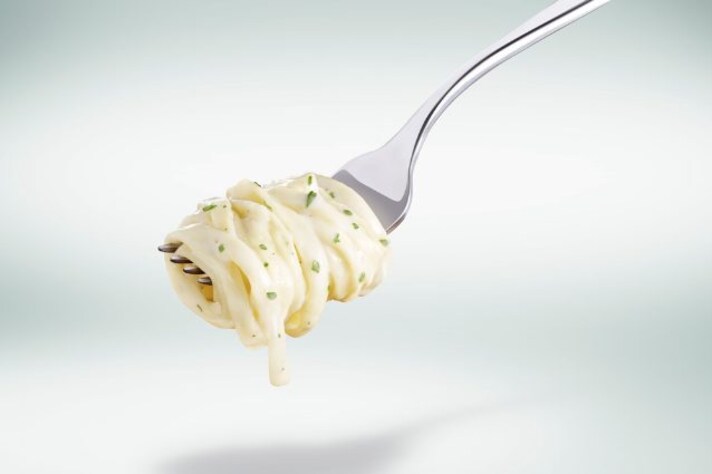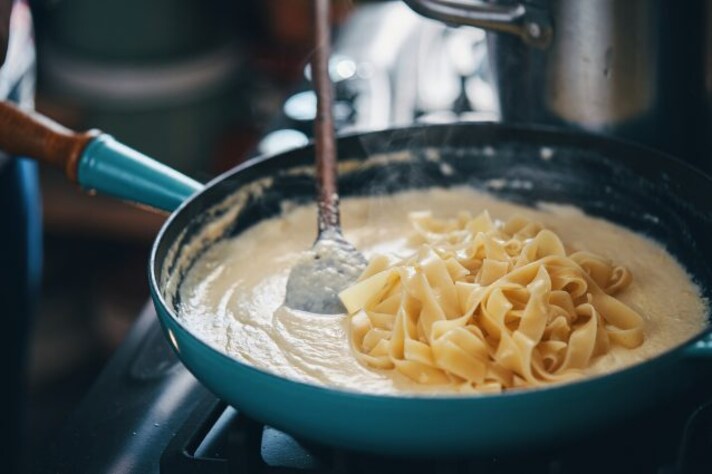
Picture this: you’ve just made a luscious, creamy Alfredo sauce. You plate your pasta, pour the sauce on top, and admire your work. It looks restaurant-worthy—until you take a bite. The first forkful is rich and flavorful, but by the time you reach the bottom of the dish, the pasta underneath is dry and bland, completely detached from the sauce. Something went wrong, but what? The truth is, putting Alfredo sauce on top of pasta instead of mixing it in is a culinary misstep that robs the dish of its full potential. Here’s why.
Alfredo Sauce Is About Emulsion, Not Decoration
True Alfredo sauce isn’t just a sauce—it’s an emulsion, a delicate balance of butter, Parmesan, and starchy pasta water that clings to the noodles, coating them in a silky, flavorful glaze. But when you simply pour it on top, you’re breaking that balance. Instead of binding with the pasta, the sauce sits on the surface, creating two separate components instead of a cohesive dish. That’s like dressing a salad by dumping a pile of ranch in the middle and hoping for the best.

The Pasta Needs to Absorb the Sauce
Good pasta dishes don’t just rely on sauce for flavor—the noodles themselves should taste like something. When you mix Alfredo sauce properly, the hot pasta absorbs the buttery, cheesy goodness, ensuring every bite is flavorful. But if you pour the sauce over the top, the pasta underneath never gets properly coated. The result? A few over-sauced bites on the surface, followed by a disappointing, under-seasoned pile of plain noodles.
Temperature Matters More Than You Think
Here’s a little secret: Alfredo sauce is incredibly sensitive to temperature. It’s made from butter, cheese, and starchy pasta water, all of which need to be at just the right heat to stay smooth and velvety. If you dump hot sauce onto already-cooled pasta, you’re shocking it, making it harder for the sauce to cling. Worse, if the sauce sits on top for too long before mixing, it can congeal, leaving you with a grainy, separated mess instead of a silky, luxurious coating.
Restaurant-Style Alfredo? They’re Doing It Right
Ever wonder why restaurant Alfredo always seems creamier, more evenly coated, and just… better? It’s because they’re mixing the sauce and pasta together before it even reaches your plate. In a proper kitchen, Alfredo isn’t poured on top of pasta—it’s tossed with the noodles over heat, allowing the sauce to bind, thicken, and cling perfectly. The best Italian chefs know that the magic happens in the pan, not after plating.

The Right Way to Do It
The solution is simple but essential: toss the pasta with the sauce while it’s still hot, ideally in the same pan you made the sauce in. Let it cook together for a few seconds, allowing the sauce to emulsify and cling to the pasta, coating every strand in its buttery, cheesy glory. A splash of pasta water can help, ensuring the sauce stays smooth and doesn’t break.
Alfredo sauce isn’t a topping—it’s a partnership between pasta and sauce, a perfect union that can only happen if you mix it in properly. So, the next time you make Alfredo, resist the urge to plate first and sauce second. Your pasta—and your taste buds—will thank you.
;Resize,width=767;)
